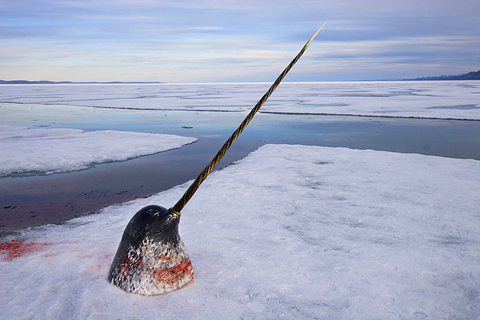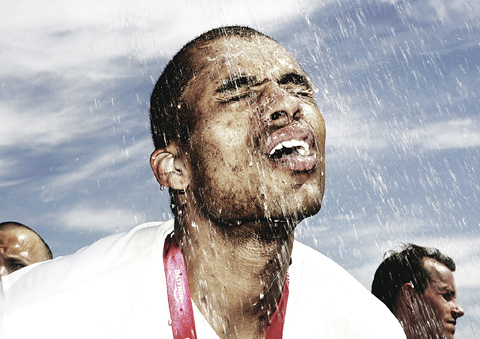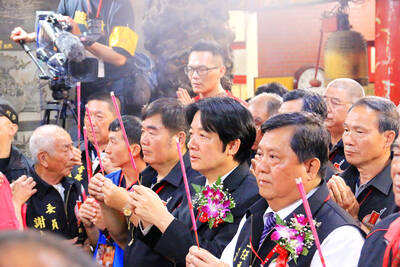The photo is dark, almost monochrome in its palate of muddy browns and greens. It shows a soldier fallen against an embankment. He is clearly exhausted. The image is slightly blurred, lacking the sharp lines and rich colors camera companies want consumers to think are the hallmarks of a good photo. But this is no castoff. This is the World Press Photo of the Year for 2007, an image chosen from among 80,536 submissions to the World Press Photo Foundation. The foundation's international exhibition, which will visit more than 50 cities this year, opens in Taipei today.
UK photographer Tim Hetherington captured the image as part of a photo series taken in Afghanistan for Vanity Fair magazine. The series won second prize in the General News Stories category.
"The main thing why this photo has become World Press Photo of the Year is that this picture is a metaphor, it's not just of one guy who is tired of a day of fighting, who's signed up to fight in a country he has never been to before, ... the Korengal Valley [in Eastern Afghanistan] has more engagements than anywhere in the world, more than in Iraq, more than in Congo ... over 135 contacts in a month, this guy is tired, but this picture is actually a metaphor for the fact that the world is tired of these kinds of wars. It's not just the man who's exhausted, the world is exhausted, ... this picture tells that story: that's what counts, that's what makes this World Press Photo of the Year," said Sander Goudswaard, curator of the World Press Photo Exhibition in Taipei.

PHOTO: COURTESY OF THE WORLD PRESS FOUNDATION
The 2007 World Press Photo Exhibition began at the end of April and now has 15 sets of prints touring internationally. These edits of the winning entries do not include all the photos, as many of the photo essays are massively compressed. "If we didn't do this," Goudswaard said, "the show would simply be too big." All photos in the single photo category are included, but the images in the photo story categories are edited down to a number of representative images. All winning photos can be accessed on the World Press Photo Web site, which also contains extended interviews with some of the winning photographers.
For Goudswaard, the exhibition is as much about the photographers as about the images themselves.
"World Press Photo is a contest for professional photographers. It's not just a contest of photography. We want to support those people who invest time, invest money and invest a lot of effort in trying to tell and communicate different stories from around the world," he said, speaking about the difference between the photographs in this exhibition and images captured by members of the public by chance on their cell phone or compact camera.

PHOTO: COURTESY OF THE WORLD PRESS FOUNDATION
A good example is a photo by South African Brent Stirton that depicts rangers evacuating the bodies of four dead mountain gorillas in Virunga National Park, in Democratic Republic of Congo. It won first prize for a single image in the Contemporary Issues category.
"This image has been really appealing to a lot of people. ... You ask why [the gorilla is being carried out of the forest], then you start reading, and then you discover that this picture has so many layers," Goudswaard said.
Choices such as Hetherington and Stirton's photos are typical of the judges' selections for 2007.

PHOTO: COURTESY OF THE WORLD PRESS FOUNDATION
"When you see this year's winners they are really challenging. The winners that were chosen are not obvious and easily understandable photography. It is photography that makes you read the caption. It challenges you [to ask] what is it, what is going on here, why is this subject photographed. What does it want to say? It makes you think, it makes you want to read, makes you want to understand. It makes you take an extra step," Goudswaard said, adding that many photographers were very happy with this aspect of this year's event.
The World Press Photo Foundation was founded in 1955 with the aim of improving the quality of photojournalism. In addition to the awards and the traveling exhibition, the foundation actively seeks to encourage the transmission of skills and sharing of knowledge through classes and workshops.
"We put a lot of energy into analyzing which countries are underrepresented and we try to encourage participation from these areas," Goudswaard said. "The more images we get in, taken from more different angles, the better the result can be in the end."

PHOTO: COURTESY OF THE WORLD PRESS FOUNDATION
This year, 5,019 photographers from 125 countries submitted works. The foundation continues to extend the range of participation to countries with little access to formal training for press photographers.
"We hooked up with local organizations, sometimes a university, sometimes a journalist association and we try to set up a lot of workshops. For example in the Philippines and in Nigeria, over the last three years we have helped set up education for photojournalists and now we back out and they are able to carry it on their own. In this way we can support press photography really at the roots of where it is happening," Goudswaard said.
To highlight the success of World Press Photo's expansion into the developing world, Goudswaard pointed to the three winners from China this year, as well as the success of Nigerian photographer Akintunde Akinleye who won the Spot News Single category in 2006 for a photo taken after a gas pipeline explosion in Lagos.

PHOTO: COURTESY OF THE WORLD PRESS FOUNDATION
"He was part of the first year of our education program in Nigeria. He was one of the first to come and say he wanted to be a photojournalist and then five years on he is one of the winners in the contest," Goudswaard said. "This is investment and our success can be measured in how many people entered from these countries. You don't know who's going to win, but there are rising numbers of entries from areas were we have had education projects, and though this cannot be measured exactly ... if these people work in photography, that means photography can play a better role. And that is our aim."

The Democratic Progressive Party (DPP), Chinese Nationalist Party (KMT), and the country’s other political groups dare not offend religious groups, says Chen Lih-ming (陳立民), founder of the Taiwan Anti-Religion Alliance (台灣反宗教者聯盟). “It’s the same in other democracies, of course, but because political struggles in Taiwan are extraordinarily fierce, you’ll see candidates visiting several temples each day ahead of elections. That adds impetus to religion here,” says the retired college lecturer. In Japan’s most recent election, the Liberal Democratic Party lost many votes because of its ties to the Unification Church (“the Moonies”). Chen contrasts the progress made by anti-religion movements in

Taiwan doesn’t have a lot of railways, but its network has plenty of history. The government-owned entity that last year became the Taiwan Railway Corp (TRC) has been operating trains since 1891. During the 1895-1945 period of Japanese rule, the colonial government made huge investments in rail infrastructure. The northern port city of Keelung was connected to Kaohsiung in the south. New lines appeared in Pingtung, Yilan and the Hualien-Taitung region. Railway enthusiasts exploring Taiwan will find plenty to amuse themselves. Taipei will soon gain its second rail-themed museum. Elsewhere there’s a number of endearing branch lines and rolling-stock collections, some

Last week the State Department made several small changes to its Web information on Taiwan. First, it removed a statement saying that the US “does not support Taiwan independence.” The current statement now reads: “We oppose any unilateral changes to the status quo from either side. We expect cross-strait differences to be resolved by peaceful means, free from coercion, in a manner acceptable to the people on both sides of the Strait.” In 2022 the administration of Joe Biden also removed that verbiage, but after a month of pressure from the People’s Republic of China (PRC), reinstated it. The American

This was not supposed to be an election year. The local media is billing it as the “2025 great recall era” (2025大罷免時代) or the “2025 great recall wave” (2025大罷免潮), with many now just shortening it to “great recall.” As of this writing the number of campaigns that have submitted the requisite one percent of eligible voters signatures in legislative districts is 51 — 35 targeting Chinese Nationalist Party (KMT) caucus lawmakers and 16 targeting Democratic Progressive Party (DPP) lawmakers. The pan-green side has more as they started earlier. Many recall campaigns are billing themselves as “Winter Bluebirds” after the “Bluebird Action”